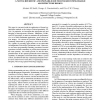Free Online Productivity Tools
i2Speak
i2Symbol
i2OCR
iTex2Img
iWeb2Print
iWeb2Shot
i2Type
iPdf2Split
iPdf2Merge
i2Bopomofo
i2Arabic
i2Style
i2Image
i2PDF
iLatex2Rtf
Sci2ools
FPL
2006
Springer
2006
Springer
A Novel Heuristic and Provable Bounds for Reconfigurable Architecture Design
This paper is concerned with the application of formal optimisation methods to the design of mixed-granularity FPGAs. In particular, we investigate the appropriate mix and floorplan of heterogeneous elements: multipliers, RAMs, and LUT-based logic, in order to maximise the performance of a set of DSP benchmark applications, given a fixed silicon budget. We extend our previous mathematical programming framework by proposing a novel set of heuristics, capable of providing upper-bounds on the achievable reconfigurable-to-fixed-logic performance ratio. Moreover, we use linear-programming bounding procedures from the operations research community to provide lower-bounds on the same quantity. Our results provide, for the first time, quantifications of the optimal performance/area-enhancing capability of multipliers and RAM blocks within a system context, and indicate that only a minimal performance benefit can be achieved over Virtex II by re-organising the device floorplan, when using opti...
Achievable Reconfigurable-to-fixed-logic Performance | Fixed Silicon Budget | Formal Optimisation Methods | FPL 2006 | Hardware |
| Added | 22 Aug 2010 |
| Updated | 22 Aug 2010 |
| Type | Conference |
| Year | 2006 |
| Where | FPL |
| Authors | Alastair M. Smith, George A. Constantinides, Peter Y. K. Cheung |
Comments (0)

